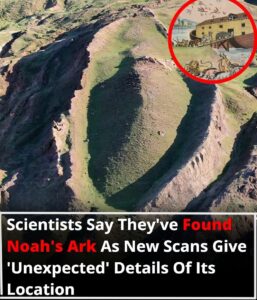Scientists Believe They’ve Discovered Noah’s Ark Using Breakthrough Radar Technology

New underground scans reveal possible remnants of a legendary vessel
In what could be a historic revelation, a group of U.S.-based researchers claim they’ve uncovered compelling evidence pointing to the final resting place of Noah’s Ark—a discovery that could bring one of the Bible’s most iconic stories closer to reality.
The Ark, famously described in the Book of Genesis, was said to be a massive wooden vessel built to survive a catastrophic global flood. According to scripture, it carried Noah, his family, and pairs of every animal species to safety. For centuries, the idea of finding the Ark has fascinated believers and explorers alike.
Now, a fresh set of high-resolution radar scans may be the closest science has come to actually locating it.
Hidden Beneath the Earth in Turkey
The research, led by independent investigator Andrew Jones and a loosely formed team known as Noah’s Ark Scans, zeroes in on a peculiar boat-shaped land formation at the Durupinar site in eastern Turkey. This site is roughly 18 miles south of Mount Ararat—the very mountain mentioned in Genesis as the Ark’s resting place.
What makes this location so fascinating? It measures an astonishing 538 feet in length—the exact size the Bible gives for Noah’s Ark. But there’s more.
Using ground-penetrating radar, the team detected unusual underground features, including what appears to be a central corridor measuring over 13 feet wide. Additional scans suggested the presence of symmetrical chambers and multiple levels, consistent with the biblical instructions to construct the Ark with three decks (Genesis 6:16).
Jones told the Christian Broadcasting Network, “It’s precisely what you would expect if this were an artificial structure, matching the dimensions and layout described in scripture.”
Signs Beneath the Surface
But the evidence doesn’t stop at structural anomalies. Soil tests revealed striking differences between the interior and exterior of the boat-shaped area.
According to William Crabtree, a soil expert working with the team, the inner section’s soil showed elevated potassium, lower pH levels, and richer organic material—indicators that support the theory of decaying wood material buried beneath the ground.
“If a large wooden ship had rotted over thousands of years, that’s exactly the kind of chemical footprint we’d expect to find,” Crabtree noted.
In addition, the grass growing within the formation displays a noticeably different color compared to the surrounding area, further suggesting unique underground conditions.
A Long-Lost Vessel or a Natural Formation?
Although the team remains cautious, they believe the site may represent what Jones calls a “chemical shadow” of the original Ark. He explained that they’re not expecting to find intact planks or beams, but rather remnants and traces that strongly indicate human construction.
“This isn’t what you’d find if the formation were simply solid rock or the result of a natural mudslide,” Jones stated.
He and his colleagues are now seeking to perform core drilling at the site, a move that could offer even deeper insight into whether this is truly an ancient, man-made structure buried below the surface.
Could This Be the Real Ark?
While the discovery is still in its early stages, the alignment of biblical measurements, underground anomalies, and soil composition has fueled speculation that this could be the closest anyone has come to verifying the Noah’s Ark legend.
Only time—and further excavation—will tell whether this boat-shaped site in Turkey holds the answers to one of humanity’s oldest and most enduring mysteries.